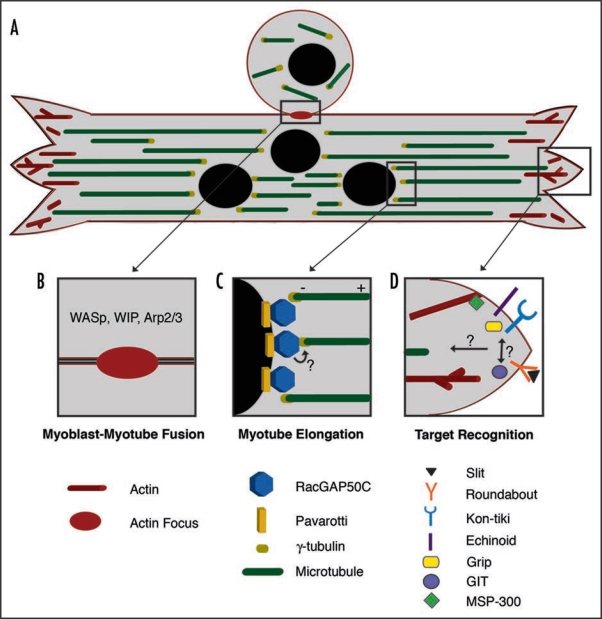Figure 1.
Multiple roles of the cytoskeleton during Drosophila myogenesis. (A) Muscle assembly requires multiple steps, some of which occur simultaneously. Shown is a myoblast fusing to a multinucleated myotube as it elongates and searches for the proper attachment sites. The actin cytoskeleton (shown in red) is required for fusion at the central region of the myotube as well as at the myotube ends for target recognition during muscle attachment site selection. A polarized microtubule array (green) is found along the linear axis of the myotube with minus ends anchored near the nuclei, at the interior of the muscle fiber (black) and the plus ends directed outwards. (B) Myoblast-Myotube Fusion. Recent studies have shown that a dense actin focus (red oval) is critical for myoblast fusion to a multinucleated myotube. The formation of the actin focus is driven by actin regulators such as WASp, WIP and Arp2/3. (C) Myotube Elongation. Myotube elongation requires a uniform microtubule array based at the nuclear periphery. Through interaction with Pavarotti, RacGAP localizes to the nuclear periphery where it colocalizes with the microtubule nucleator protein γ-tubulin to establish a polarized microtubule array. It is not clear whether RacGAP and γ-tubulin directly interact in the myotube. (D) Target Recognition. Many molecules accumulate at myotube ends where they are required for the selection of appropriate attachment sites. These molecules include the well-known axon guidance molecules Slit and Roundabout. Kon-tiki and Echinoid are also involved in myotube target recognition, and both molecules are able to bind Grip, a downstream scaffolding protein. These molecules are required for target recognition within the same subset of myotubes, but it is unclear how they are coordinated. The Drosophila homologue of GIT was also recently implicated in target recognition. To date, common downstream signals that direct cytoskeletal rearrangements required for target recognition remain largely unknown. MSP-300 may be one molecule that mediates actin dynamics at the plasma membrane.

